
Understanding sentiment analysis: A detailed guide
The need for a sophisticated understanding of audience sentiment has never been more critical due to the ever-evolving digital space. Sentiment refers to the attitude, opinion or feeling toward something, such as a person, organization, entity, product or topic. And by analyzing sentiment, businesses are able to measure positive, negative or neutral opinions about their brand or service.
In the webinar, titled, ‘Death to Sentiment’, CEO of Pulsar, Francesco D’Orazio outlines the journey of sentiment analysis, from the point it begun gaining traction and popularity in 2004 to the point where marketers keen to stay ahead of the curve are well aware of its limitations.
Although those who are already familiar with sentiment analysis will understand the necessity to go beyond this generic model for more effective and actionable insights. Sentiment analysis coming into the picture marks a significant milestone in the evolution of understanding customer sentiment, owing to the eruption of subjective text available on the web. Notably, this technique has revolutionized many industries and even surpassed the broader category of 'customer feedback’ over time.
Yet, despite its advances and capabilities, sentiment analysis presents us with a narrow lens. The problem lies not in the science or technology behind it, which are advanced and have made significant progress. Instead, the issue is in the questions we're asking and the knowledge we’re attempting to obtain. Identifying what sentiments exist in relation to your brand or service doesn't provide a complete picture - it's just the first step. To truly engage with audience sentiment, marketers must delve deeper to understand why these sentiments exist and how to interact with the customers expressing these opinions meaningfully.
Paying attention to the limitations of generic sentiment analysis is where audience intelligence steps in, taking sentiment analysis to a whole new level. Moving towards audience intelligence isn't about discarding sentiment analysis but enhancing it with a more sophisticated approach.
The integration and involvement of vertical AI helps us understand not just how the audience feels based on the opinions expressed but also why they feel this way, as well as offering insights into how these sentiments impact brand reputation, customer journey, and brand purpose perception.
In this guide, we will journey through the evolving landscape of sentiment analysis and the transformative power of audience intelligence, providing you with actionable insights to craft effective and actionable marketing strategies.
Table of Contents
- What is sentiment analysis and how does it work?
- The role of natural language processing (NLP) in sentiment analysis
- Sentiment analysis data: Understanding its limitations
- Customer sentiment analysis and the role of audience intelligence
- Utilizing sentiment analysis tools for enhanced audience intelligence
- Brand sentiment
- Sentiment analysis in social media: A case for audience intelligence
- Twitter sentiment analysis
- The future of sentiment analysis
What is sentiment analysis and how does it work?
Sentiment analysis, sometimes called opinion mining, is a process that supports businesses in monitoring brand and product sentiment in customer feedback to help understand consumer needs and wants.
Businesses can gauge whether people feel positively or negatively about their offerings by digging into comments, reviews, and social media chatter. But that's only part of the picture. While traditional sentiment analysis offers a valuable snapshot of public sentiment at a given moment, it often presents a simplified view - telling you how people feel without always revealing why they feel that way, categorizing sentiments into basic positive, negative, or neutral categories. This approach can miss out on the subtleties and complexities of human emotion and opinion.
For example, it might not fully capture the context, irony, or cultural nuances in the text; it could miss out on understanding why sentiments exist or how to engage with them meaningfully; the dynamic and evolving nature of online language can make it challenging for traditional sentiment analysis to keep pace.
The role of natural language processing (NLP) in sentiment analysis
As outlined by technology corporation, IBM, Natural Language Processing (NLP) is like teaching computers to understand human conversation. It's a branch of Artificial Intelligence (AI) that enables machines to interpret and 'understand' text and spoken words just like humans do while factoring in the emotion and intentions behind them.
NLP dives into linguistics foundations, analyzing components like grammar (syntax), meaning (semantics), context (pragmatics), and word formation (morphology) to extract meaning from text and speech.
When it comes to sentiment analysis, NLP is the driving force. It allows computers to sift through thousands of social media posts, reviews, or comments and understand human emotions, context, sarcasm, and more.
Think of NLP as the engine powering sentiment analysis. With NLP, marketers can quickly gauge whether the buzz about a brand, product, service or event is positive, negative, or neutral. It's a vital tool that offers a snapshot of public sentiment, providing valuable insights for businesses to act upon.
Sentiment analysis data: Understanding its limitations
While the science behind sentiment analysis and NLP is advanced and well-developed the data it derives is not without its limitations for several reasons.
So, what does sentiment analysis data encompass? In simple terms, sentiment analysis data primarily revolves around taking subjective information, and turning it into objective data that can be analyzed.
Let’s take a collection of product reviews as an example. The subjective information in these reviews is the “I love it”, “it’s okay”, or “I hate it”, and these opinions are transformed through sentiment analysis into numbers and categories (objective data). These labels could look like scores (50, 0, or -50), or descriptors “positive”, “neutral”, or “negative”. This allows businesses and marketers to transform subjective data or public opinion into actionable insights that can guide more informed decisions.
As an example, we’ll explore our research on the trend ‘Barbiecore’, acquired using Pulsar TRAC and detailed in our Webinar, “Cultural Moments: Barbiecore to Negroni Sbagliato”. The below visualization outlines the nature of conversation concerning the trending topic Barbiecore online.
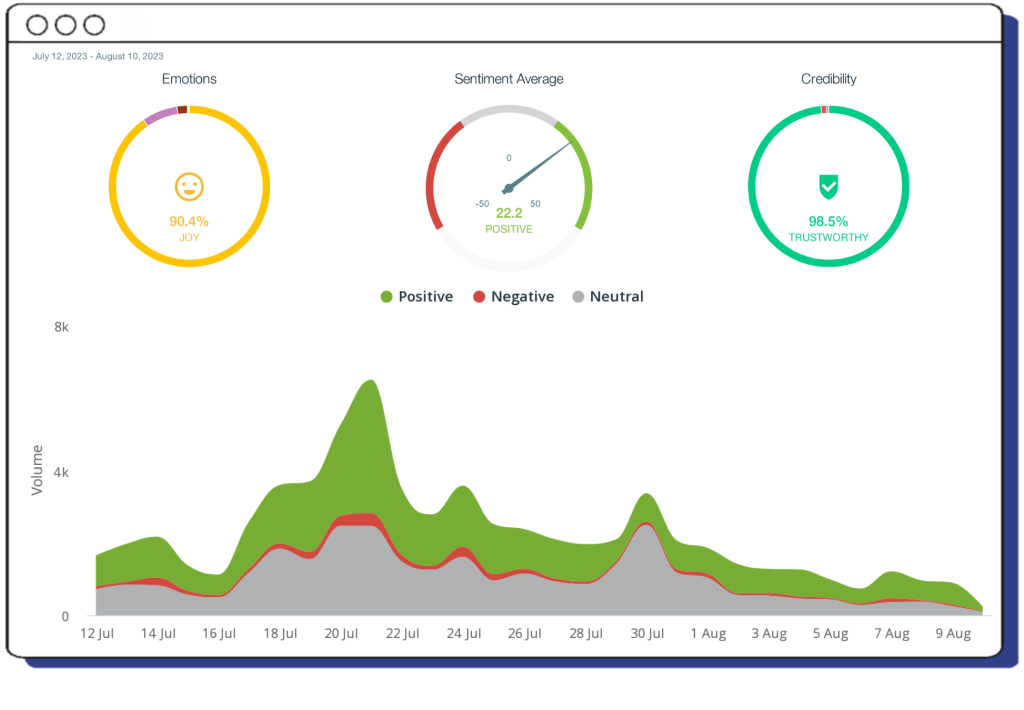
Barbiecore is an aesthetic trend characterized by vibrant pink hues and bold, playful accessories, inspired by Mattel’s Barbie doll. While it’s had a resurgence, coinciding with the release of Greta Gerwig’s Barbie movie, Barbiecore draws on nostalgic elements of Y2k fashion - a period when Barbie’s influence was significant amongst popular culture. But beyond fashion trends and aesthetics. Barbiecore represents so much more; it’s a trend that embraces hyper-femininity by reclaiming an aesthetic synonymous with Barbie that was once rooted in women’s bodies and their sexuality.
As seen in the above data on the nature of conversation surrounding the trend “Barbiecore” online, Pulsar TRAC indicates that the overall sentiment is positive, and 90.6% of people feel joy towards the subject. And while this knowledge is insightful by providing a general understanding of how your audience or customers are receiving the reemergence of Barbiecore online, what else can we take away from this data?
As we’ve already established, simply understanding what sentiments are out there concerning a trend, your brand, business, or product isn’t enough and should be just the first step. To truly resonate with your target audience, it’s vital to go beyond this and understand why people feel this way and how to interact with the audience members expressing these opinions for optimal results.
Customer sentiment analysis and the role of audience intelligence
As we've explored so far, sentiment analysis, at its core, is a powerful tool. It allows businesses to track feelings towards their brands and adjust strategies accordingly. However, it's not immune to limitations. These limitations aren't necessarily due to the technology itself but to the depth and granularity of the questions we pose to the data.
The true potential of sentiment analysis comes to fruition when combined with the capabilities of vertical AI. Vertical AI, designed for specific tasks, allows us to dive deeper into unstructured data, extracting richer insights. With this, businesses can structure data in ways that provide more than a sentiment score, gaining the capability to understand the reasons behind these sentiments and their implications.
Let's bear this in mind while considering the complex nature of public opinion. A positive or negative sentiment might tell a brand whether customers like their products or are happy with their services without necessarily conveying why or how this sentiment affects a brand's overall reputation. It won't provide insights into things like the stage in the customer journey these sentiments become most apparent or how they relate to a brand's message or purpose. These nuances can become clear with the combined power of sentiment analysis and vertical AI.
This refined approach allows businesses to move beyond just knowing the sentiment. It lets them understand the behaviors driving this sentiment, the impact on the audience, and how these sentiments affect the brand's reputation or messaging online. By enriching sentiment analysis, businesses can derive actionable insights from their research. Understanding not just what sentiments customers are expressing but also why they exist means marketers can tap into their audience's thoughts and feelings, enabling them to connect with their audience in a way that will matter.
Utilizing sentiment analysis tools for enhanced audience intelligence
As the landscape of sentiment analysis has evolved, tools that harness the power of vertical AI have emerged, offering businesses deeper and more nuanced insights into audience perspectives. Instead of providing a monolithic view of sentiment, sentiment analysis tools, like Pulsar, use vertical AI to dissect unstructured data into fine-grained, granular insights.
For example, while standard sentiment analysis might inform a brand that a product launch has been well-received, advanced tools can reveal intricate details. They might show that the positivity largely stems from innovative product design, while there appear to be mixed sentiments about its functionality. Such insights empower brands to celebrate successes and directly address areas of concern, showcasing a commitment to customer feedback.
As well as this, sentiment analysis tools often come equipped with functionalities that allow brands to chart the journey of a sentiment. For example, determining at which touchpoint customers feel most engaged or understanding a specific event, new release or campaign that triggered a surge in positive or negative opinions.
This approach, rooted in the power of vertical AI, transforms sentiment data from a mere reactive metric to a proactive tool. Brands can forecast trends, anticipate customer needs, and strategically align their efforts with their audience, surpassing customer expectations.
By leveraging the capabilities of sentiment analysis tools, businesses are doing more than just listening to their audience; they're deeply understanding and effectively engaging with them.
Brand sentiment
Beyond gauging reactions to campaigns, new releases, and products, sentiment analysis is invaluable for understanding how consumers perceive a company (brand sentiment) - reflected in reviews, social media comments, blog discussions, and even casual conversations.
Gauging brand sentiment is an essential component of sentiment analysis. Positive sentiments foster brand growth and loyalty, whereas negative sentiments risk the opposite - if not identified and addressed. But, remember, successful sentiment analysis requires more than simply revealing opinions. Brands must dive deeper to understand the root causes of these sentiments if they aim to derive actionable insights.
Consider the statement: “X is my favorite brand, but its prices are too high.” Traditional sentiment analysis tools might categorize this as ‘neutral’. In contrast, advanced tools equipped with vertical AI capabilities can distinguish between the positive sentiment towards the brand and the negative about pricing. Such granularity empowers brands to respond effectively, pinpointing specific areas, like product pricing, that may need adjustments to better align with customer expectations.
Sentiment analysis in social media: A case for audience intelligence
While you can gauge public opinion from several sources, including reviews, blog comments, surveys and polls, news outlets, online forums, such as Reddit, and so on. Social media platforms, like Twitter, Instagram and Facebook unearth a vast amount of user-generated content.
Let’s dive back into the “Barbiecore” trend to further explore social media sentiment analysis.
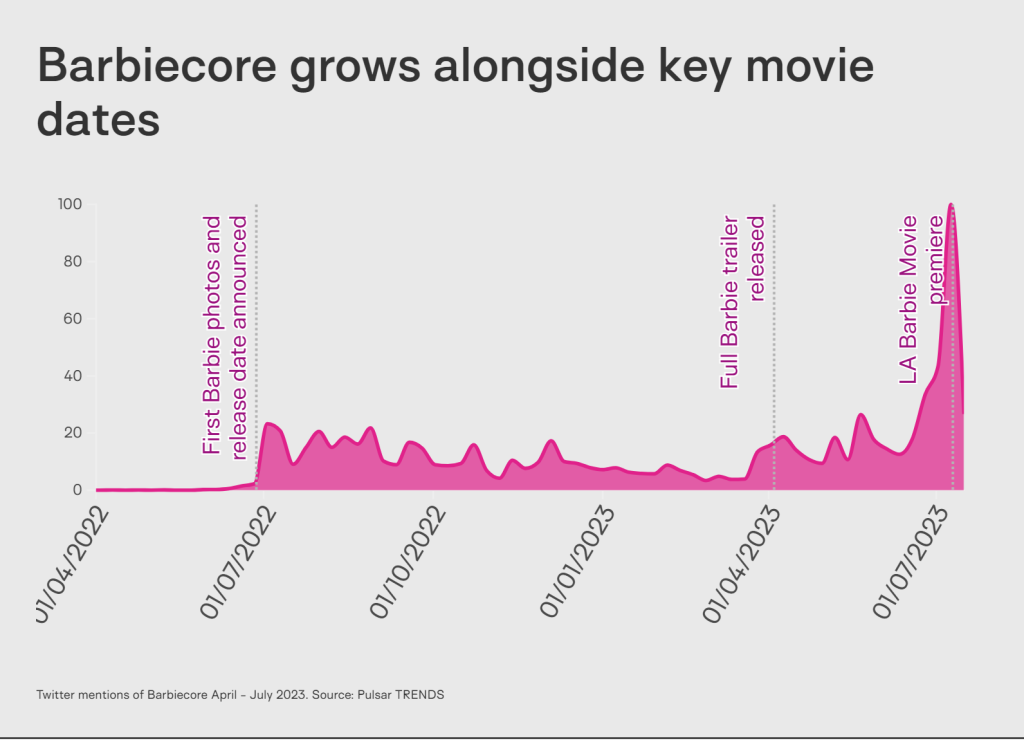
This data tracks the Twitter mentions of Barbiecore using Pulsar TRENDS. Showcasing moments the trend spikes in line with Greta Gerwig’s Barbie Movie events, including the full Barbie trailer and LA premiere. With such clear online interest and growth of the Barbiecore trend and movie, it's the perfect opportunity to explore the associated sentiments.
Twitter sentiment analysis
X is known for its extensive user base, providing a rich ground for sentiment analysis. Millions of tweets express feelings, opinions, and reactions to events, brands, and products on a daily basis. By harnessing this vast collection of real-time data, businesses and marketers can tap into public sentiment on a mass scale about almost anything.
Let’s turn back to our data on “Barbiecore” as an example.
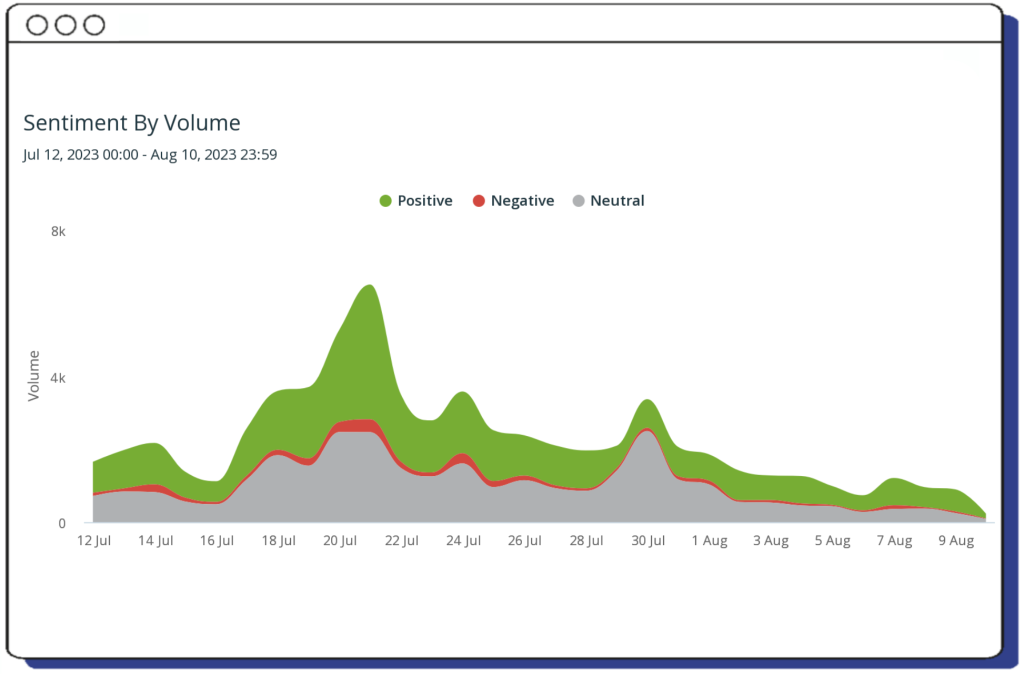
When looking at sentiment over time, you can clearly see the peak volume sitting at 21st July, the day the Barbie Movie was released, public opinion surrounding the trend “Barbiecore” being majority positive. When talking about "volume" in relation to posts, it means the number of positive, negative or neutral mentions or comments about a specific topic, brand, product, event, etc.
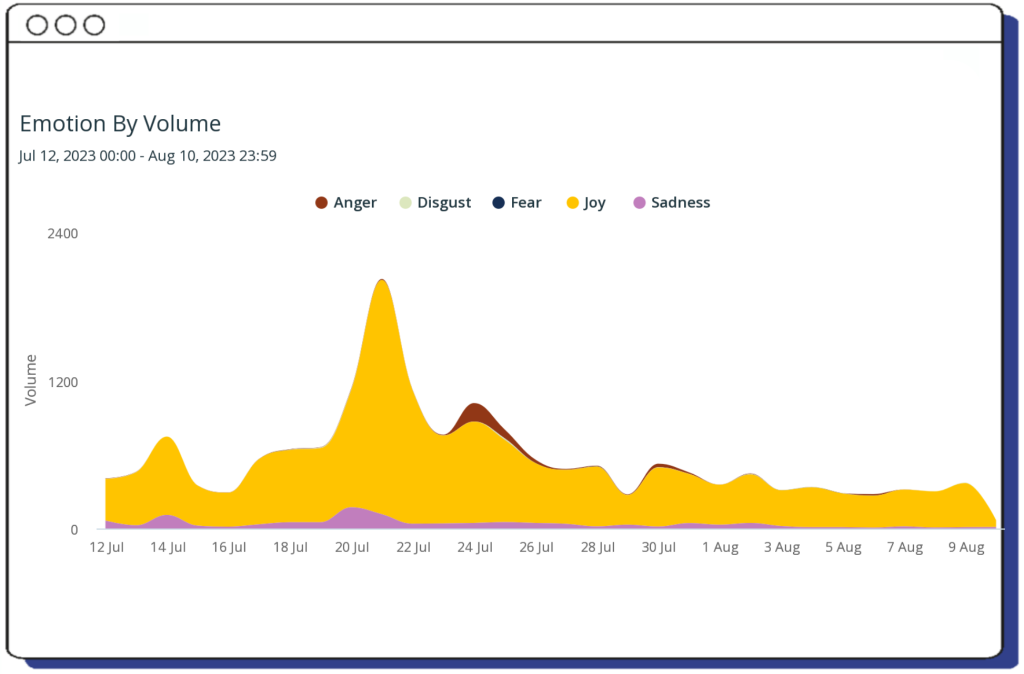
Using Pulsar TRAC, beyond positive, negative and neutral labels, you can also gain insight into the emotion detached behind each sentiment. The above graph highlights that as the “Barbiecore” trend was received almost entirely positively on social media, the most dominant emotion by volume was “joy” in relation to the trend.
Given the unique ecosystem where hashtags shape and propagate trends, let’s now take a look at the Hashtags Treemap on Pulsar TRAC to delve into the hashtags used on social media surrounding the “Barbiecore” trend.
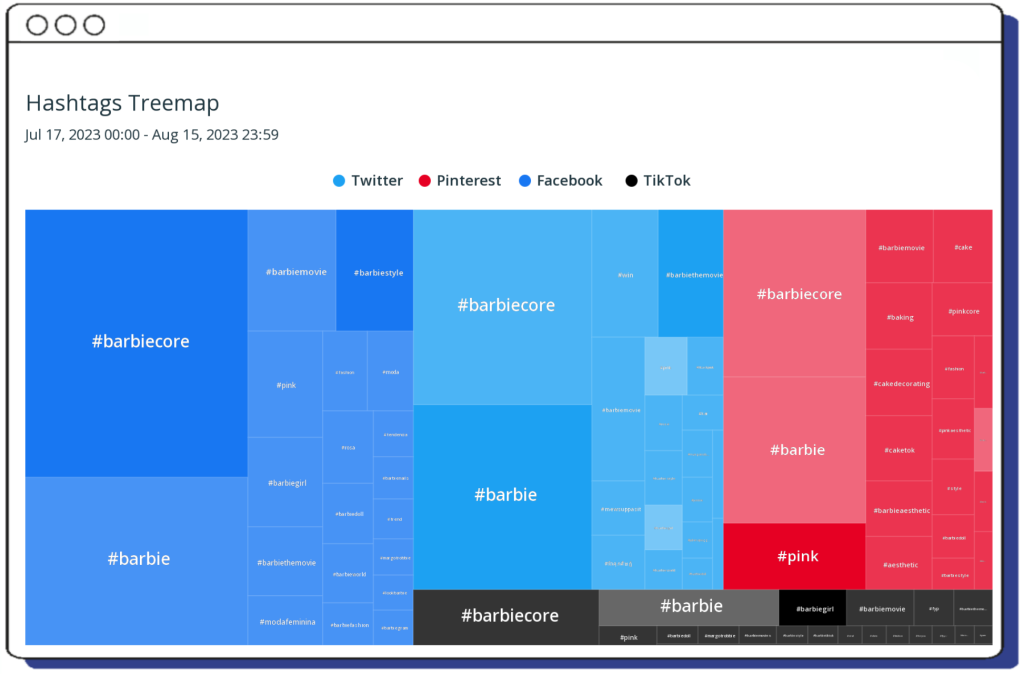
As you can see, while “#barbiecore” was one of the most popular hashtags in relation to the aesthetic fashion trend, other standout hashtags on Twitter were “#barbie”, “#barbiemovie”, “#barbiestyle”, “#pink”, and “#fashion”.
These top hashtags are indicative of the trend, it being aesthetic-based. Hashtags, including “#pink” and “#fashion”, reinforce the link between Barbiecore and distinct stylistic and color choices at the heart of the trend.
But what does this begin to tell us about sentiment? For example, these hashtags could indicate that users are embracing and celebrating the Barbiecore trend by integrating it into broader discussions on fashion and style, extending its reach far beyond the Barbie Movie alone.
Bearing this in mind, let's now explore the hashtags by sentiment.
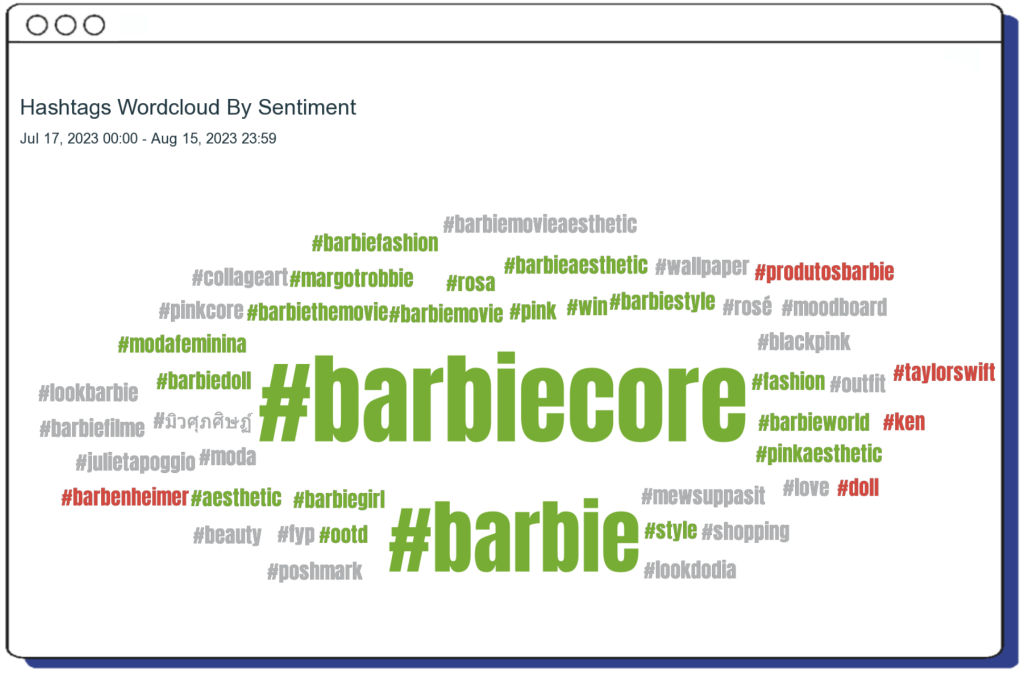
In this visualization, the bigger the hashtag, the more volume of mentions associated with that subject. So, while hashtags, such as “#barbiecore” and “#barbie” are overwhelmingly positive, receiving a majority of occurrences within conversations online in association with the Barbiecore trend, hashtags in gray represent the hashtags associated with neutral, and red hashtags with negative sentiments.
Social media platforms, especially Twitter, serve as valuable realms for real-time public sentiment. Through the lens of the "Barbiecore" trend, we've seen how social media sentiment analysis offers businesses a deeper understanding of audience perceptions.
The evident benefits of using audience intelligence tools to enhance your sentiment analysis is the ability to capture real-time data, subtle nuances, and an emotional spectrum. Brands aiming for success must recognize that generic sentiment analysis alone is insufficient; integrating real-time data and comprehensive audience intelligence is crucial for keeping us with ever-evolving public opinion and emerging trends.
The future of sentiment analysis
While sentiment analysis is a powerful tool, as we've outlined, it offers just a glimpse into public opinion. To fully harness its potential, it's vital to go beyond generic sentiment analysis, enhancing its abilities with audience intelligence. This combination offers a deeper dive into the 'why' behind sentiments, enabling more effective business strategies and a better understanding of audiences.
